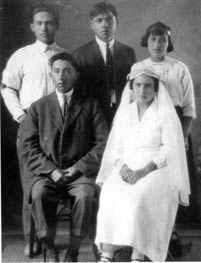Life Cycles
The Secwepemc people went through many rituals throughout their lives. These rituals shaped and cultured the people so they would respect all things from the living to the dead.
For instance, when a woman became pregnant restrictions were placed on the woman and her husband. She was not allowed to eat certain foods or do certain things for the sake of the baby she carried. She was not allowed to look at ugly or deformed things so the baby would have its likeness. The woman went into isolation preceding birth. With the possible exception of her husband she was left on her own. After a child was born, his umbilical cord was ritually buried on the ancestral land of his people, symbolically attaching him to the land. The mother and father were then released from restrictions. The baby would receive a name during a public feast. Most names chosen were hereditary.
 At
puberty, both girls and boys underwent ritual and practical training to
prepare them for adulthood. Girls were secluded during their first menses.
Boys began their training when their voice changed. Throughout their adolescence
they spent periods of four days to several weeks to obtain their guardian
spirit. Honor and respect was achieved and proved their adulthood. Upon
completing their training, boys and girls were considered able to marry.
At
puberty, both girls and boys underwent ritual and practical training to
prepare them for adulthood. Girls were secluded during their first menses.
Boys began their training when their voice changed. Throughout their adolescence
they spent periods of four days to several weeks to obtain their guardian
spirit. Honor and respect was achieved and proved their adulthood. Upon
completing their training, boys and girls were considered able to marry.
The most honorable form of marriage took place when the bride's mother and father made the first approach to the groom's parents. Both sets of parents prepared a ceremonial event where gifts were given and a feast held. The suitor "touching" the bride he desired during dances and public ceremony contracted some marriages.
Following the death of an individual, a burial place on a sandy plateau
overlooking a river was chosen. His or her soul departed from the body
through a process lasting four days. During this time a wake was held.
A fire was kept to communicate with
 the
departed soul, and food and tobacco were burned to nourish the deceased
along his journey. Personal possessions of the deceased were buried along
with him. The dead were tied in the fetal position in a circular grave,
which is not practiced now. Stones or a small circular hut was placed on
top. Flags or sticks with ribbons were set near the site. Their animal
hides were also hung near the site. A communally provided feast to thank
those who consoled and helped the mourners and to lighten their spirits
followed the burial. During this feast, the guests would play lehal with
the stakes provided by the family of the deceased.
the
departed soul, and food and tobacco were burned to nourish the deceased
along his journey. Personal possessions of the deceased were buried along
with him. The dead were tied in the fetal position in a circular grave,
which is not practiced now. Stones or a small circular hut was placed on
top. Flags or sticks with ribbons were set near the site. Their animal
hides were also hung near the site. A communally provided feast to thank
those who consoled and helped the mourners and to lighten their spirits
followed the burial. During this feast, the guests would play lehal with
the stakes provided by the family of the deceased.
| Home / Table of Contents | Previous |